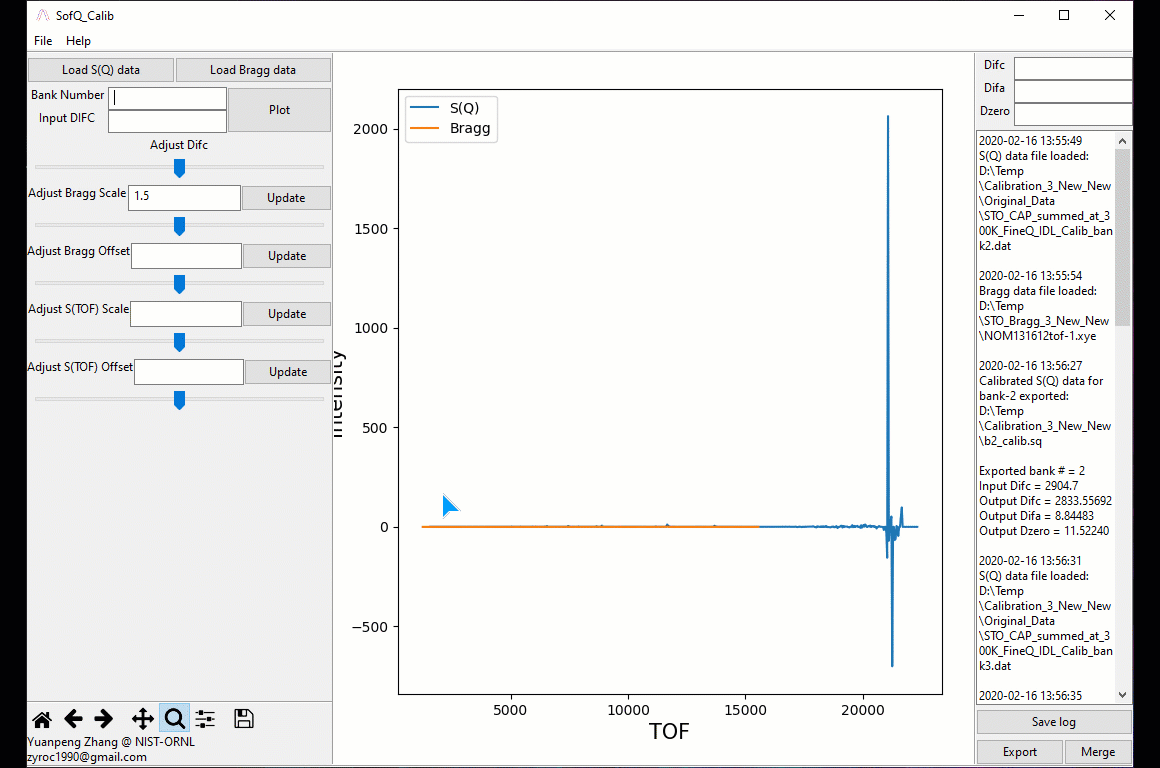Solution to the commonly observed inconsistence between X-ray and neutron calibration
Background Introduction
The calibration issue is fundamentally concerned about the transformation in between d-spacing, wavelength and scattering angle, given the Bragg condition of scattering. Suppose we could possibly have hundred percent accurate measurement of those engineering values such as wavelength and scattering angle, we would then not have any issue with performing the transformation into d-space accurately. However, in practice, this is not the case, given multiple origins of inaccuracy, e.g., sample position shift, inaccurate measurement of detector positions, etc. Sepcifically for time-of-flight (TOF) neutron scattering, to solve this issue (i.e., inaccurate engineering measurement), a standard sample (e.g., diamond) would always be used to calibrate the instrument, i.e., to establish an accurate transformation from TOF to d-space. However, even we could perform an accurate calibration with a standard sample, still there would be issues since it cannot be guranteed that the sample position will be identical to that of the standard sample. Usually, if staying within TOF world, this might not be a critical issue since even the peak positions would be a bit off, measurements performed with the same experimental setup should be self-consistent. It is just that when we try to compare in between measurements taken at different instruments, or between neutron TOF and X-ray measurement will we have inconsistent peak positioning.
Solution to the Calibration Issue
To cope with the inconsistent peak positioning issue (e.g., between neutron TOF data and X-ray data measured for the same sample), one could use Rietveld refinement as an intermediate tool and treat X-ray as the reference that one would like to line up to. Talking about Rietveld refinement for TOF data, here it is worth noting the difference between the treatment for total scattering and Bragg data. Usually, for total scattering data, one would directly take the calibrated data (as mentioned earlier, with a standard sample such as diamond), bring it into Q-space and perform the Fourier transform to obtain the pair distribution function (PDF) pattern. For Bragg data, what one usually has is the data in TOF-space, and in practice, Bragg data for a standard sample (typically, Si) would be measured and refined before the sample data refinement. For refining the standard Si model, one could then fix the well-known lattice parameter and refine those calibration parameters. In the case of neutron TOF data, those parameters would be DIFC, DIFA and TZERO, given the transformation between TOF and d-spacing as ‘TOF = DIFA * d^2 + DIFC * d + TZERO’. Then for sample data fitting, one could fix the DIFC and TZERO parameters, leaving DIFA still refinable to account for the potential sample position shift as compared to the standard sample (in this case, Si). Following such a procedure, we ‘believe’ the instrument is well calibrated. Still, one may see inconsistent lattice parameters between neutron TOF Bragg data fitting and the X-ray data fitting. But that is probably the best one could do.
At this point, one could treat the X-ray data as the golden standard and redo the TOF data fitting for the same sample. This time, one could fix the lattice parameters to those values obtained from X-ray data fitting and leave, again, the DIFA value to be refinable. The next thing one needs to do is to worry about the total scattering – to line it up against the already ‘well calibrated’ TOF Bragg data. To do this, one could use a little tool called ‘sofq_calib’ developed by ORNL team (refer to this link for installation instruction. Contact Yuanpeng at [email protected] if any issues). Detailed instructions could be found within the program – after installation, the GUI could be launched from command line by ‘sofq_calib’, or if one is using Windows, a shortcut could be found in the start menu. A demo GIF is attached below for reference.

The basic idea is to:
- Load in S(Q) data bank by bank and transform it temporarily to TOF-space. The influence of potential sample shift upon TOF-d transformation is different from bank to bank due to scattering angle difference. Therefore, we have to cope with the calibration issue bank by bank.
- Load in the Bragg data in TOF-space.
- Adjust the temporary DIFC value for the specific bank loaded in, so that the S(Q) and Bragg data overlaps as much as possible.
- At this point, one could use the scale and offset slide bar for better visualization and comparison.
- Use the DIFC, DIFA and TZERO values obtained through Rietveld refinement for this specific bank to transform the TOF-space S(Q) data back into Q-space.
- Merge all S(Q) banks – one may want to select continuous but non-overlapping regions for each of the banks and then connect the patterns together manually to give the final pattern in the full Q-space.
- Specifically for NOMAD diffractometer at SNS, it is strongly recommended to use the high resolution bank (i.e., bank-5) as much as possible.
- The principle for selecting ranges for banks to merge may be – use those banks with peaks as sharp as possible.

